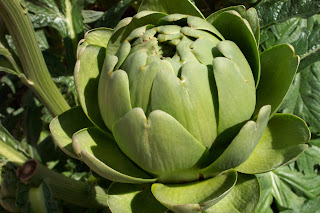One of my favorite things to do when I wake up in the morning, and when I get home at night, is to check the latest developments in the garden, water plants that aren't connected to the drip system just yet and snap various photos of amazing produce.
This is one of those photos.
Yes, you can grow artichokes in the Sacramento Region. We got this beauty during one of our first years for gardening. I've never seen an artichoke quite this big before, and can't even tell you WHAT variety this is, other than it's a big one, of course. Because we had a very small backyard, we were limited in what we could plant, and what we could allow to grow. Artichokes are BIG plants. And they will spread out and take over a yard if you let them. We couldn't allow that. We just didn't have the room. Fortunately, you can train artichoke plants to grow any way you want them to grow. And, with the use of some strong stakes and a lot of twine and string, we forced our plants to grow UP rather than OUT.
Here is one example of that growing method. You can clearly see the fence in the back of this photo. And this artichoke plant is well over six feet tall at this point, and would probably grow to a height of eight feet before it was all said and done.
I quickly found out that I was going to run into trouble one year, when I noticed an abundance of new artichoke plants in the artichoke bed. Where there had been four plants, there were now seven or eight to take its place. I was, of course, thrilled. The thinking was: "eight plants will certainly produce more artichokes than four plants!" Good thinking! Bad idea!
You see, as I mentioned earlier, artichokes will fight for space. It's a battle for the biggest, baddest plant in the bed. And the smaller plants? Well, they just tend to get "pushed aside" by the big bullies. Although I did notice some of the plants near the outer edge of the bed starting to lean a bit, I thought nothing of it. After all -- the plants just needed room to grow, right?

Then, one morning, I came outside to discover an artichoke plant that had been loaded with four or five delectable chokes, snapped from its base and fell over on the sidewalk, dead. The artichokes I had been planning to eat: history. Gone. Deflated. Into the trash bin they went. At that point I suddenly realized that the same thing was about to happen to about two or three other plants that were slowly getting forced out of the bed by other, stronger plants. What to do?
Venus and I put our heads together and decided that we had to stake those leaning plants up somehow to keep them from bending over so far that they would SNAP and fall over. That meant a trip to the man's toy store -- Home Depot -- the purchase of a few strong metal stakes and some string and twine.
I hammered those stakes into the center of the bed, then used twine and string to rope around the middle part of the leaning artichoke plants, pulling the string tight to force the plants back into the bed and back into a more upright position, before tying off that string on the posts.
It worked wonders. It really did. And then, and only then, did I discover that I had nailed one of those posts straight into the drip line buried four inches below the soil line. So, not only did I save my artichoke plants, I created a new fountain!
DOH! Another trip back to the man's toy store for new drip hoses, connectors, you name it....







